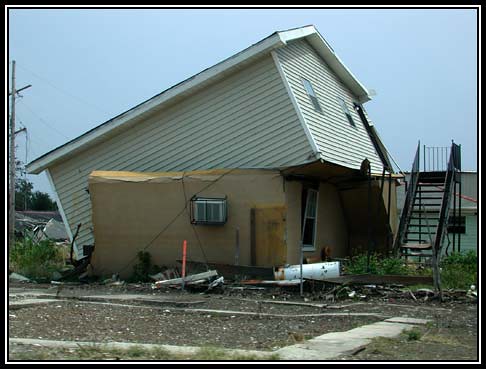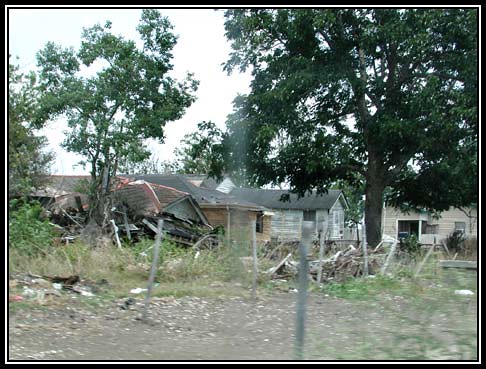The Last in the Series
Jul. 1st, 2006 01:23 am
After a while this all started to feel like just more of the same thing. More ruins of houses, more ruins of businesses, more ruined lives. One pile of trash looks just like any other pile of trash. One road with weeds growing through cracks in the asphalt lined with rotting buildings is all but indistinguishable from another.
I had no idea where I was during any part of the driving tour and I still don’t know where I was today. There was just mile after mile of destruction. Streets filled with abandoned dreams and lives ruined by nature and man’s indifference.

Somebody knows this street, knows who used to live in this house.
Now they’re all gone, with very little to return to and even less in place to make that return possible.

I thought about this last entry this afternoon as I was driving back from setting up our booth and the Festival for the Eno. I was searching for something that would sum all of this up, some larger context to give these images and my experiences with them some deeper meaning.
I do know that I’ve learned a great deal more than I had imagined I would when i first felt the pull to go through these damaged areas.
This was the first time I ever felt that I, with my camera, had a duty, a responsibility to perform. There have been thousands of people photographing the destruction and lack of recovery in New Orleans, and my contribution wasn’t going to bring about any big changes, but I could still make the effort. I could document what I saw as best I could and then try to share that knowledge with people around the world.
The events that these images represent are, to me, part of a larger message that the former and current citizens of these areas need the rest of us to know about.

I have learned that the power of an image, even an image captured by someone as limited in talent and experience as myself, can still be powerful.
I have learned that those images can retain their power long after the actual event has passed. Working with them in a different time, place and environment makes little difference as to the impact they can produce.
I have learned that while there are no easy solutions to the largest of our problems, doing nothing and hoping they’ll go away is not only stupid but also morally wrong.

Over at DemocraticUnderground, Aquart has graciously linked to my last two blog entries to try and spread the word among some of the DU readers.
Tonight DU reader and blogger intheflow replied with comments on my images. He pointed me to his images of the Mississippi Gulf region and they were, in many ways even more impressive than my own. His photo essays from December 2005, February 2006 and June 2006 are not only well documented, but heartbreaking as well.

I wish I had some way of wrapping this series up properly.
But, I don’t.

When I first heard about the levee break on August 29, 2005 my first reaction was that New Orleans was gone for good. I knew how far below sea level the city was and even if the flooding didn’t completely wipe the city out, there was going to be such massive destruction that I doubted the city would be able to find the financial resources to come back at all.
I followed the stories for days and then for weeks (thanks to Anderson Cooper’s 360 on CNN) afterward. With the waters not receding and the toxic chemicals from cars, homes and pesticides in the mix, I was certain that the flooded areas were not going to be habitable for decades to come unless a massive SuperFund-style clean-up effort was funded.
And I doubted that would happen.
I also felt New Orleans should not be rebuilt. It was a city waiting for a disaster like this one to strike and wash it completely away. If rich people want to build homes without insurance by the ocean’s edge, knowing that one day that house might well get washed away by a huge storm, that’s one thing. When it’s an entire city that lacks the ability to finance the relocation, recovery and return efforts, then that mistake shouldn’t be allowed to happen again.

Now, however, I’m not so sure.
Clearly, New Orleans will never be the same as it once was. People who were relocated have established new lives, built new communities and new extended families. Many do not want to return. (I can’t say that I blame them)
What I can’t overlook, however, is that there are many people who do want to return. They want to reclaim their lives, their heritage and become proud New Orleanians once again. And they are waiting on their elected officials in all branches of government to serve their electorate and put the programs in place to assist in getting those people back into their homes and re-established in their communities.
That the big government officials are putting up roadblocks to this expectation only makes me want to see as many people be allowed to return to New Orleans as fast as they possibly can.
I went down to New Orleans thinking that it was the Great American Underdog story. I thought the underdog part was due to Katrina.
Katrina was only the first step in the process. What Katrina did more than anything, I think, was to expose the truth behind the government’s caring and concerned facade and show them all to be the out-of-touch, greedy, unconcerned fools they really are.
Should New Orleans come back? In some manner, yes. If only to show the politicians that no matter how little the politicians may think of the people, the people of the city know that they are more important, that their will is stronger than that of any politician.

I’d like to thank Lance Hill, adjunct professor at Tulane University for his time, knowledge and the driving tour that gave me the chance to learn about this area and the human/political conditions that allowed this to happen.
I’d also like to thank each one of you, dear readers. Whether you’ve commented or not, I know you’ve looked at these images and, hopefully, taken something away with you.

I’d like to dedicate all of these entries and images to the people of New Orleans. Those that lost their lives in the floods, those that lost their homes, their livelihoods and their dreams in the floods and those that are really working to make the city come alive again.
I’d also like to dedicate these entries and photos to the people who came from across the country to work on the relief efforts after Katrina hit. Those of you who put your lives on hold to attempt to help out total strangers simply because you felt you could do something to make a difference, you are the ones who continue to keep that small part of my soul from giving in completely to the pessimism that these images seem to cry out for
You all will be in my prayers for a long, long time to come.

...





































































